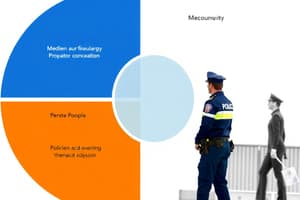Podcast
Questions and Answers
Which city's police department developed CompStat?
Which city's police department developed CompStat?
- Philadelphia
- Boston
- New York City (correct)
- Los Angeles
Since when has CompStat been in some form of application?
Since when has CompStat been in some form of application?
- 1989
- 1984
- 1994 (correct)
- 2004
What is the primary emphasis of CompStat?
What is the primary emphasis of CompStat?
- Officer wellness programs
- Public relations
- Community engagement
- Examining data to direct police resources (correct)
What do police commanders have to explain at CompStat meetings?
What do police commanders have to explain at CompStat meetings?
Smart policing emphasizes the use of what?
Smart policing emphasizes the use of what?
Which federal agency began soliciting grant proposals for smart policing initiatives?
Which federal agency began soliciting grant proposals for smart policing initiatives?
In what year did the BJA make its first 10 SPI awards to police agencies?
In what year did the BJA make its first 10 SPI awards to police agencies?
Smart policing programs can significantly reduce violent crime in which city, according to the text?
Smart policing programs can significantly reduce violent crime in which city, according to the text?
In which city can problem-solving teams prevent violence in stubborn chronic hot spots?
In which city can problem-solving teams prevent violence in stubborn chronic hot spots?
Intelligence-led policing originated in?
Intelligence-led policing originated in?
Intelligence-led policing is based on the idea that a relatively small number of people are responsible for a comparatively large percentage of _________.
Intelligence-led policing is based on the idea that a relatively small number of people are responsible for a comparatively large percentage of _________.
What is the simple equation for intelligence, according to the text?
What is the simple equation for intelligence, according to the text?
What is required for collected data to become intelligence?
What is required for collected data to become intelligence?
Who keeps their fingers on the pulse of crime in the jurisdiction?
Who keeps their fingers on the pulse of crime in the jurisdiction?
What does CompStat require police commanders to generate?
What does CompStat require police commanders to generate?
What does smart policing emphasize in addition to data and analytics?
What does smart policing emphasize in addition to data and analytics?
What do police and academics do together in smart policing?
What do police and academics do together in smart policing?
What is reduced in historically violent police districts because of smart policing?
What is reduced in historically violent police districts because of smart policing?
According to police in Great Britain, focusing on which offenses reduces crime more effectively?
According to police in Great Britain, focusing on which offenses reduces crime more effectively?
What type of professional analyzes collected data to produce intelligence?
What type of professional analyzes collected data to produce intelligence?
Flashcards
What is CompStat?
What is CompStat?
A crime management tool developed by the NYC Police Department in 1994. It uses data to direct police resources and requires commanders to explain their tactics, resources, and collaborations.
What is Smart Policing?
What is Smart Policing?
An offshoot of CompStat that emphasizes data, analytics, improved crime analysis, performance measurement, and evaluation research.
What is Intelligence-led Policing?
What is Intelligence-led Policing?
An approach originating in Great Britain, focusing on prevalent offenses to reduce crime.
Intelligence definition
Intelligence definition
Signup and view all the flashcards
Study Notes
CompStat
- A crime management tool used by many agencies since 1994
- Developed by the New York City Police Department
- CompStat's emphasis on examining data to direct police resources has been very successful
- Some describe it as "revolutionizing law enforcement management and practice"
- Others call it "perhaps the single most important organizational/administrative innovation in policing during the latter half of the 20th century"
- Police commanders must generate frequent crime activity reports
- Officers must proactively consider ways to deal with crime in terms of suppression, intervention, and prevention.
- At CompStat meetings, commanders must explain the tactics they have used to address crime patterns
- They must explain the resources they have and need
- They must state with whom they have collaborated
Smart Policing
- A more recent concept and offshoot of CompStat
- Emphasizes the use of data and analytics, improved crime analysis, performance measurement, and evaluation research
- In June 2009, the federal Bureau of Justice Assistance (BJA) began soliciting grant proposals for "smart policing" initiatives (SPI)
- The goal was to identify or confirm effective crime-reduction techniques that other agencies could replicate
- Research partnerships were the most important element of SPI, emphasized by the BJA
- Police and academics worked together to test solutions informed by crime science theories and sound evaluation
- As of 2009, the BJA made its first 10 SPI awards to police agencies
- Grants have been awarded to dozens of local law enforcement agencies conducting SPI projects
- Smart policing programs can significantly reduce violent crime (Philadelphia)
- Creative use of crime analytics and crime analysis resources, coupled with targeted problem-solving approaches, can reduce violent crime in historically violent police districts (Los Angeles)
- Problem-solving teams can prevent violence in stubborn chronic hot spots (Boston) and reduce service calls and property crime at troubled high-traffic convenience stores (Glendale, Arizona)
Intelligence-Led Policing
- Originated in Great Britain
- Police believed that a relatively small number of people were responsible for a comparatively large percentage of crimes
- Officers could reduce crime more effectively by focusing on the most prevalent offenses occurring in their jurisdiction
- Intelligence is information
- "Information plus analysis equals intelligence," and without analysis, there is no intelligence
- Intelligence is what is produced after the collected data were evaluated and analyzed by a trained intelligence professional
- Crime analysts monitor crime in the jurisdiction to determine which crime is occurring
Studying That Suits You
Use AI to generate personalized quizzes and flashcards to suit your learning preferences.



